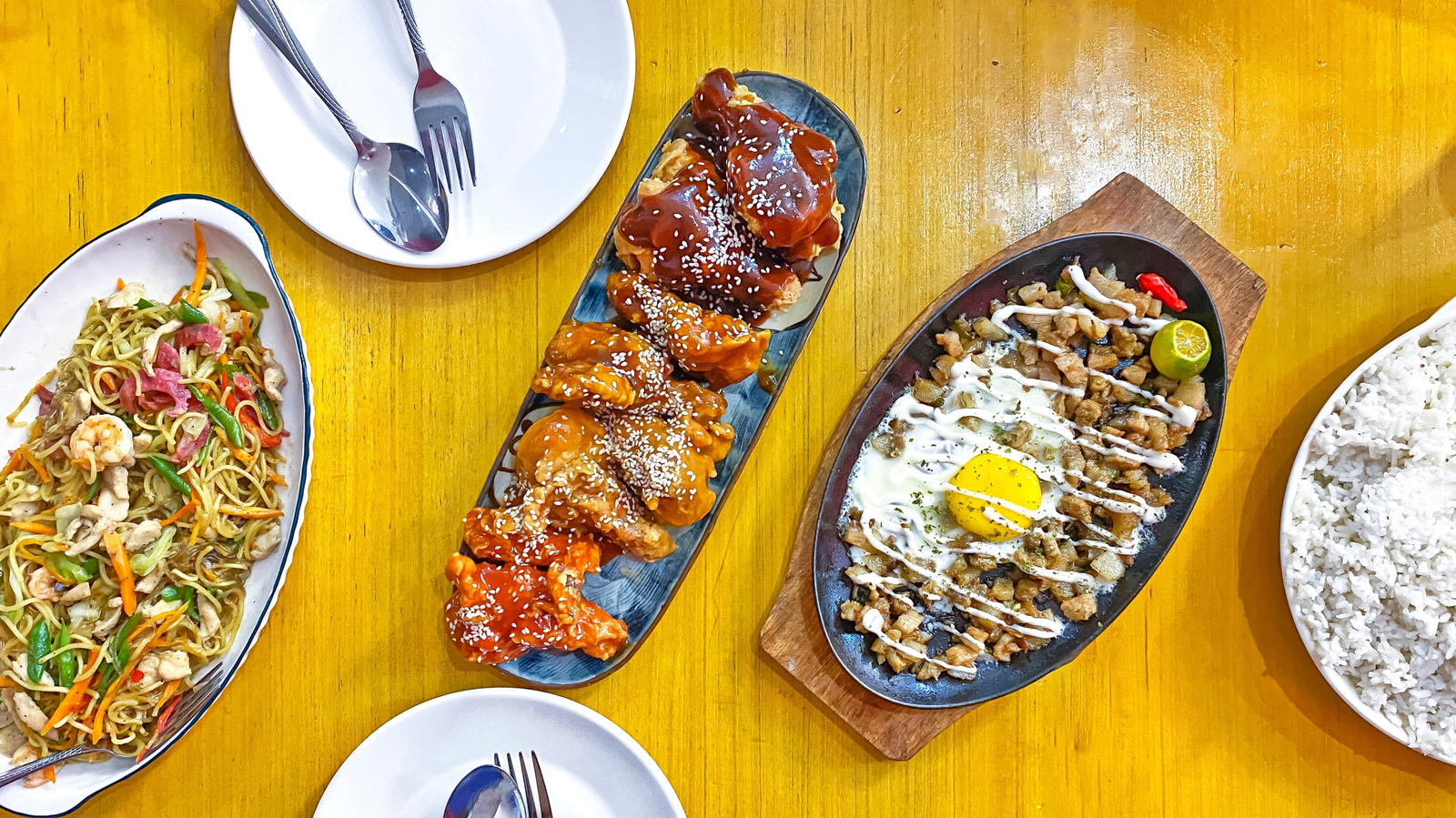Looking for your next foodie fix? Have you tried Filipino cuisine? With a tropical maritime climate, the Philippines has a bounty of seafood, fertile soil for crops, and mountains of fantastically fresh fruit. Due to its strategic position in the Pacific, the Philippines has seen Spanish, Japanese, and American occupation, as well as heavy influence from China, and the local cuisine today speaks to all these influences. From crispy spring rolls, spicy stewed beef, and slow-cooked pork, to sticky-sweet fruity desserts, there’s a whole world of flavor here to experience. Filipino cuisine should be on the radar of any curious foodie.
Cities across North America boast large, thriving Filipino communities. From Toronto to Los Angeles, Filipino cuisine has made its mark. Search for a spot near you and give this fabulous fare a try! And if you find yourself further afield, you can also look up a recipe and try your hand at making some traditional Filipino dishes at home.
Chef Maricel Gentile of Maricel’s Kitchen is passionate about sharing her home flavors with the world. She talked us through her favorites, and you can find many of these recipes in her cookbook. Gentile and several other culinary experts filled us in on the must-try staples of this rich and flavorful cuisine. “Filipino food is fine food,” says Gentile. “It’s family food. It’s joyful food.” If that sounds good to you, read on to tantalize your taste buds and inspire your next meal.
Lumpia
Everyone we spoke to gave a shout-out to lumpia, and in particular, Lumpiang Shanghai came up. These crispy pork spring rolls are a staple. Most of us associate spring rolls with Chinese food (and it’s no surprise this dish is named for a city in China), but there are many regional variations with different twists on the filling and wrapping. Some Vietnamese spring rolls are made with rice paper, while egg rolls are made from wheat. The Filipino classic is filled with seasoned ground pork.
A quintessential appetizer and party food, Maricel Gentile says Lumpiang Shanghai are “golden and crunchy on the outside, savory and juicy on the inside,” and perfect for large gatherings. Rose Sioson, owner at Deliciously Rushed, agrees and assures us they are “totally addictive and always a crowd-pleaser.” If you’ve got a lot of vegetarians in your group, Gentile recommends their “vegetarian cousin,” Lumpiang Gulay.
Chicken adobo
“Chicken adobo is our national dish for a reason,” says Chef Maricel Gentile. And it could be one of the only Filipino dishes you’ve already heard of, even if you’re not particularly familiar with the cuisine. A braised chicken dish, Gentile says, “it’s deeply flavorful, comforting, and incredibly easy to fall in love with.” Luckily, she assures us it’s also pretty simple to make. For the curious home chef, this is one you can definitely attempt at home. If you’re not near an Asian market, you don’t necessarily need anything special to make chicken adobo. Pantry staples and a little know-how should do the trick.
The ingredients in chicken adobo are chicken thighs (skin on or off will work), vinegar, soy sauce, garlic, and black pepper. Throw in a little brown sugar, maybe a bay leaf, and get cooking. Gentile tells us there are thousands of variations on the recipe that may add ingredients like coconut milk or turmeric, but they all start with a vinegar base. If you feel like getting into some fusion, you can try chicken adobado street tacos.
Gentile advises braising the chicken low and slow. Time is the key ingredient with a braised dish, ensuring that the final results are greater than the sum of their parts. Powerful flavors like vinegar and soy are mellowed during a long cook, and these results will be succulent and super flavorful. “It’s not just a dish,” says Gentile, “it’s a story of our culture, our history, and our deep connection to food that’s as nourishing as it is unforgettable.”
Lechon
Chef Rena Awada of Healthy Fitness Meals calls Lechon a must-try Filipino dish. “It’s basically a whole roasted pig,” she explains, “and it’s crispy on the outside, juicy on the inside.” Eat it on its own with rice, and it’s already wonderful, Awada says, but you can level up your lechon with a special dipping sauce or vinegar. She tells us you’ll often find lechon at large family gatherings in the Philippines. This is celebration food. But you’ll likely find some at your local Filipino restaurant, too, anytime you feel like giving it a try. It’s truly a signature dish.
Chef Maricel Gentile goes for lechon belly and adds lemongrass for extra aromatic flavor. Instead of roasting a whole suckling pig, make things a little more manageable by focusing on one of the favorite cuts, pork belly, and getting it just right. “This is the kind of dish that turns heads the moment it hits the table,” says Gentile. But it’s key to get the skin “perfectly crackling and crisp.”
Pancit
This one’s for the noodle lovers. If you order Shanghai noodles at a Chinese restaurant, or opt for Pad See Ew or Pad Woon Sen when you go for Thai, you will almost certainly love pancit. “No Filipino spread is complete without pancit,” says Chef Maricel Gentile, “our beloved noodle dishes that symbolize long life and celebration.”
There are many regional variations of this favorite, which is sure to be present at any family gathering, Gentile tells us. Pancit Bihon employs thin rice noodles while Pancit Canton uses thicker egg noodles and oyster sauce. Additions like shrimp, chicken, pork, sausage, and veggies add lots of protein, flavor, and textural dimension to the dish. You can easily make lighter or heavier versions, and adjust the components to your liking.
Bistek tagalog
Bistek tagalog is another safe entry point to Filipino cuisine for the curious but cautious eater. Who doesn’t love a nice piece of steak with some fried onions? If there’s anyone less adventurous at your table, this is probably a safe bet. But that doesn’t mean it’s not packed with flavor. Seasoned with soy sauce and calamansi juice (you can probably use lime in a pinch), this seared, stewed, thinly sliced steak is absolutely full of flavor.
It’s no surprise that Golan Haiem, CEO of Destination Wagyu, ranks this among his top Filipino dishes. He says it’s the kind of dish that can “let the high-quality premium beef speak for itself.” It’s suitable for the discerning palate, but if you know you like a little extra flavor (and you’re not sure about more adventurous dishes), start here with Filipino steak and onions.
Sinigang
Time for some soup! If you need something to warm you up, Filipino cuisine has loads to offer, starting with sinigang. Sinigang is a sour soup that’s a staple in the Philippines. Typically flavored with tamarind, there are versions that get their sour flavor from other fruits or vinegars. Tamarind is an ingredient many North Americans won’t be familiar with, but it’s commonly used in cuisines across Asia (and it’s actually quite common in Caribbean and Mexican cooking, too). A tree pod, the tamarind pulp has a uniquely sweet and sour taste. You’ll find this ingredient in whole pods, dried, pulped, juiced, or in paste form. Found in sweet and savory dishes alike, you may have come across this flavor in a Pad Thai or chutney. Its unique tang makes a special impact on the taste buds.
When it comes to sinigang, tamarind is used to flavor the broth. “It’s tangy, aromatic, and incredibly comforting,” says Chef Maricel Gentile. The soup is then typically made with pork belly meat. But Rose Sision tells us that sinigang can also be made with beef, seafood, or even chicken, “and honestly, you can’t go wrong with any version.”
Chef Rena Awada adds that this hearty dish is usually also packed with “tons of vegetables like okra, eggplant, kangkong (water spinach), tomatoes, string beans, radish, and onions.” So, this brothy Filipino comfort food comes with all the protein and veggies you need. If you feel like making one for yourself at home, boil fresh young tamarind for the broth, or you can buy tamarind concentrate or tamarind soup mix on Amazon. You can also substitute tamarind paste with ingredients you already have on hand.
Bulalo
Next up in the brothy soup category: bulalo. “A slow-simmered bone marrow beef shank soup, [bulalo] is the kind of dish that feels deeply comforting,” Golan Haiem explains. “And when it’s made with high-quality beef, it becomes something truly memorable.” The marrow in the shanks creates a rich and wholesome broth, and the meat becomes tender during a long cook. Additional chunks of pork and vegetables can be added to create a hearty meal.
Bulalo is also high up on Chef Rena Awada’s list of Filipino comfort foods. She likes hers packed with veggies like cabbage, bok choy, corn, and potatoes, along with the beef shank and marrow. “The broth is rich, savory, and super comforting,” Awada says. This is the kind of dish we’ll call simple but profound. All you need is a little patience for something truly wonderful to emerge from a handful of simple ingredients.
Kaldereta
Golan Haiem loves kaldereta, a hearty meat stew that’s often made with tougher cuts of beef like brisket or chuck. A long stewing process can break down those tougher cuts, making the meat tender. “But when you use well-marbled beef,” Haiem says, “it transforms into a rich, layered dish that still feels grounded.” He’s got his wagyu agenda in mind, surely, and how could that not yield delicious results? Whether you’re working with premium cuts or not, kaldereta can be tasty and filling.
The signature flavor of kaldereta comes from a tomato and liver paste base. And the name kalderata harkens back to the Spanish colonial past. Derived from the Spanish word “caldereta” which means a stew, this stew takes some time in the pot (or crock pot or pressure cooker), developing its thick sauce and deep, rich flavor. With added potatoes, carrots, olives, and other veggies, it’s a perfect one-pot meal.
Kare-Kare
We’re sticking with stew for a moment. “This is, without a doubt, my favorite dish of all time,” says Chef Maricel Gentile. She remembers making it with her grandmother, who ground peanuts by hand for the sauce. Kare-kare is an oxtail stew made with veggies in a thick peanut sauce. If you’re a big fan of mole or Thai peanut sauce, you may want to give kare-kare a try.
Gentile tells us it’s often served with salty fermented shrimp paste, or “bagoong,” a common Filipino condiment made from fermented shrimp paste that adds umami depth to any dish. You don’t need much to pack a punch (think fish sauce, for reference), but a little bagoong will liven up the stew. “It’s a dish that captures the Filipino love of bold contrasts,” Gentile explains, “earthy and creamy, with that deep umami from the shrimp paste that ties it all together.”
Sisig
Chef Maricel Gentile says sisig is “one of the most iconic and beloved dishes in all of Filipino cuisine.” Savory and tangy, Gentile tells us sisig is traditionally made from chopped pork, in particular from some parts of the pig many of us might overlook, like the jowls and ears. This recipe was pioneered in the Pampanga region of the Philippines during U.S. military occupation as a way to use the meat often overlooked by the Americans. The results were both resourceful and delicious. “Sisig isn’t just pork on a hot plate,” says Gentile, “it’s culture, resilience, and celebration all in one bite.”
The pork meat is first boiled and then grilled before it’s chopped and seasoned with vinegar, chilies, and calamansi (a common Filipino citrus fruit). Chicken liver is sometimes added for extra flavor and texture. This mix is then served on a sizzling plate, sometimes with a runny egg on top or maybe some mayo. However, if the thought of pig’s head gives you pause, you can make a version with pork belly instead. But the original is much beloved — it’s even Gordon Ramsay’s favorite Filipino dish.
Turon
Time for dessert! The Philippines has lots of sweet treats to offer after a hearty meal of super savory food, and today we’re starting with turon. Not to be confused with the Spanish “turrón,” an almond nougat sweet, Filipino turon is essentially a banana spring roll, like the lumpia we started this culinary expedition with. A meal that begins and ends with crispy spring rolls sounds pretty good to us.
Caramelized banana and jackfruit are wrapped in thin pastry and fried until golden. “Crisp on the outside, soft and fruity on the inside,” Chef Maricel Gentile says, “it’s as fun to eat as it is nostalgic.” If you’re feeling lazy, you can skip the caramelizing step and simply roll the banana in cinnamon sugar before wrapping and frying. Turon is often seasoned with cinnamon and served with caramel or ice cream, or both if you’re feeling decadent.
Cassava cake
Next up in the dessert category, Rose Sioson gives a shout-out to cassava cake. Cassava (also known as yuca) is a starchy root vegetable that pops up in all kinds of sweet and savory dishes. It has a pretty neutral flavor of its own and a wonderful texture. In its dried powder form, it goes by tapioca, the key ingredient in chewy boba pearls, but cassava cake calls for fresh or frozen cassava.
Cassava cake combines grated cassava and coconut, coconut milk, condensed milk, evaporated milk, and eggs to make a dessert that is “soft, chewy, and just the right amount of sweet,” says Sioson. There’s no flour in this recipe, so it’s naturally gluten-free (and grain-free to boot). But some variations include a custard topping or even some cheese.
Filipino fruit salad
Chef Maricel Gentile says no family celebration is complete without some Filipino-style fruit salad. Her version, which was her mother’s recipe, is made from tropical fruits, palm seeds, and jackfruit mixed with cream cheese, heavy cream, and condensed milk. The fruit salad should be chilled before serving and garnished with a cherry. Sounds like a dairy overload, perhaps, but Gentile promises, “it’s simple, joyful, and full of love — just like the gatherings it’s made for.”
Naturally, there are variations on this recipe that use all kinds of fruits. Many favor tinned fruit cocktails over fresh fruit. Some include additions like coconut gel, cheese cubes, or corn. But what distinguishes the Filipino fruit salad from any other is the inclusion of some cream, or whipped cream, and condensed milk. Also called buko salad, it is always served chilled, sometimes even frozen. If you like Korean shaved ice, you should probably give Filipino fruit salad a try.
Calamansi juice
Calamansi has come up already as a signature ingredient in many of the previously mentioned dishes. Sour and not too sweet, it’s something like a cross between a lime and a kumquat, green on the outside and orange in the middle. Calamansi functions in the Philippines much the way lemon functions in the Mediterranean, or lime in Mexican cuisine. Which is to say, it’s kind of integral to the cuisine. Used in marinades, broths, dressings, or as a garnish, calamansi can also be the main attraction.
Juiced and sweetened with sugar, it makes for a tasty drink that’s like lemonade. If you’re serving up a Filipino feast, this is the perfect beverage to accompany it. Rose Sioson says a cold glass of calamansi juice is “refreshing, citrusy, and the perfect way to balance all those bold, delicious flavors.”
Banana ketchup
This is less of a dish and more of a signature ingredient. We’re used to tomato ketchup here in the U.S., but this ketchup is made from a very different fruit. Made from plantains or, you guessed it, bananas, banana ketchup is one of the hallmark condiments of Filipino cuisine. It can be served alongside many of the dishes we’ve mentioned, and it’s also a key ingredient in the famed Filipino spaghetti sauce, which lends a sweeter twist to the Italian classic.
Sometimes served with sliced hot dog, Chef Rena Awada says sweet Filipino spaghetti is another staple party food. If you want to give it a try, check if there’s a Jollibee near you. The Filipino fast food chain has been popping up across the continent. It might sound odd to think of spaghetti as fast food, but rest assured, you can order some at the drive-through along with Chickenjoy fried chicken and burgers. Both of which taste great topped with banana ketchup.





